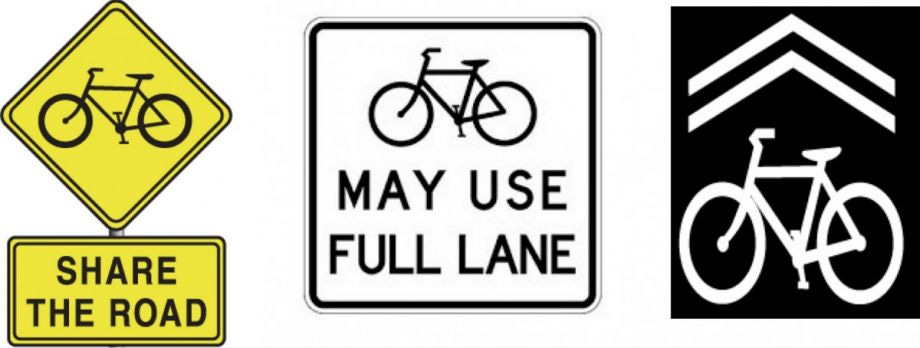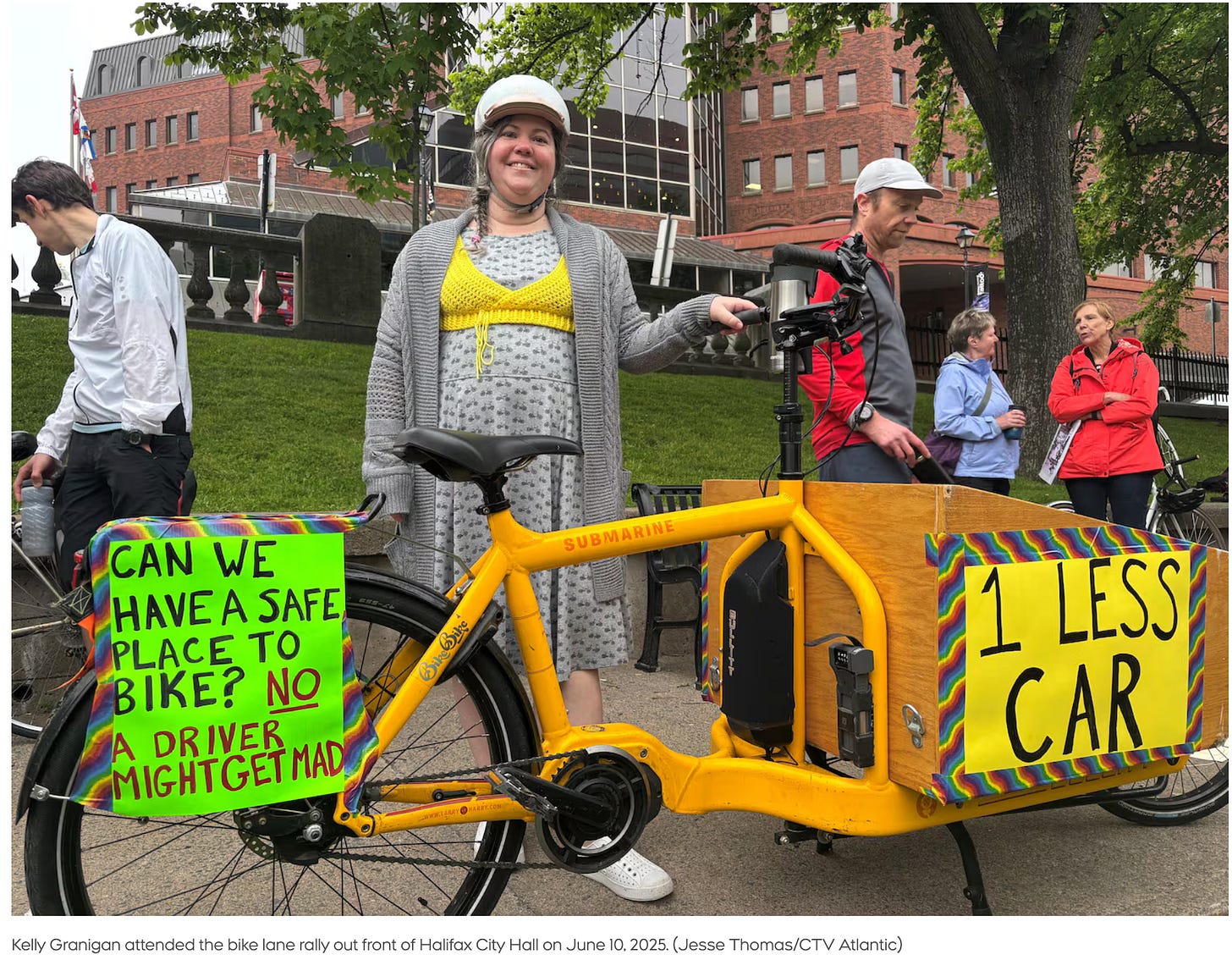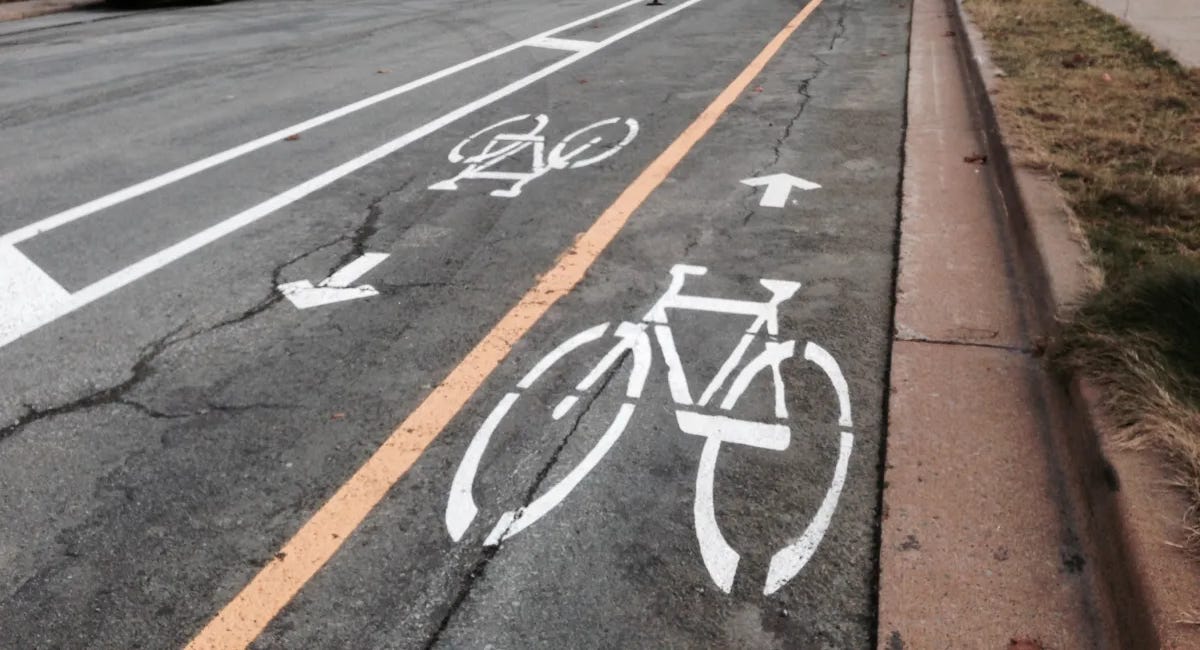The End of the Road (Is a Bike Lane)
Entropy, not outrage, is coming for Halifax’s fantasy planning model. You can’t build a functioning city on ideology, fantasy, and bad bike lanes. Stein’s Law says a crash is inevitable.
This essay is warning against magical thinking. Stein’s Law — "If something cannot go on forever, it will stop." — tells us that if we're relying on something inherently unsustainable, the question is not if it will stop—but when and how painfully.
Unsustainable trends don’t need to be stopped—they stop themselves.
Reality imposes limits that politics often ignores.
Entropy is the tendency of all systems—whether physical, organizational, or political—to move from order to disorder over time, unless energy is constantly applied to maintain or restore structure.
Unsustainable ideas don’t require opponents or protests to be brought to an end. They whither, flame out, are figured out, or they are forgotten.
But some of the simplest ideas, reinforced by positive feedback loops, will endure for hundreds of years in spite of... well, everything.
Plus – Top Ten Ideas to Improve the Current Bike Lane Build Out
AND – Ten Top Alternatives To Dedicated Bike Lanes
Stein’s Law is the aphorism: "If something cannot go on forever, it will stop."
It comes from Herbert Stein, an American economist and former chairman of the U.S. Council of Economic Advisers under Presidents Nixon and Ford.
He was known for his plainspoken wit and pragmatic conservatism. Stein coined the phrase in a 1986 article in The Wall Street Journal—but the idea had informed his thinking for years prior.
What Does It Mean? At first glance, Stein’s Law sounds like a tautology - two different ways of saying the same thing.
But it's actually a quietly devastating insight, especially in economics and policy: Unsustainable trends don’t need to be stopped—they stop themselves. For example: government debt growing faster than the economy; housing prices outpacing wages; social programs expanding faster than the tax base. Reality imposes limits that politics often ignores.
I was thinking of this last night when folks started messaging me about the result of the Halifax mayor’s request to pause the bike lane project for a review of the plan, the premises, the costs, and the rationale.
This came up in the Mayor’s Office for two reasons:
The cost and timeline projections have ballooned to about 4 times the original cost, and we’re still at least three years away from a final accounting. In government terms, we should expect the costs and timeline to increase further.
The mayor is painfully aware that this is a wildly unpopular plan with the public. His office is inundated with citizens expressing a clear message — stop it. Well, they are not saying it that politely, but the message is clear.
SIDEBAR: The Double Dutch of Bike Advocacy
I’ve been surprised—though I suppose I shouldn’t be anymore—by how many of my “bike advocate” friends have taken the “Well, people just have to learn what’s good for them” line in this debate. It’s the kind of power shrug you expect from a technocrat in a bad movie, not someone claiming the moral high ground of community improvement.
What’s startling isn’t just the smugplaining pedal-powered paternalism. It’s how quickly otherwise well-meaning people, especially those outside the political centre, those who must have some self-awareness that they exist outside the mainstream of thought, are willing to abandon even the pretense of democratic process when (or maybe because) they believe their ideology is right. Consent, consultation, conversation—all of the buzzwords go out the window the moment they think they’re on a moral mission and they have the power. And what you’re left with is something that sounds a lot like double Dutch: policy that’s unintelligible to the people it affects, pushed through with the logic of “because we said so.”
We’re not arguing about lanes anymore. We’re arguing about who decides, and what kind of city we want to live in—one where persuasion still matters, or one where the gnomes paint first and ask never.
So the Mayor asked for a pause to review. Not to review the theory or ideology. Not to review the cause — make Halifax better. But to review the actual changing facts, plans, and, you know, reality of what’s going on here.
Because — we’d all like to imagine — if the facts change it might be reasonable to change, adapt, revise, or otherwise reconsider a very costly plan at a difficult time for the city and its people.
Right?
Under what possible conditions would you change your mind?
The question—"Under what possible conditions would you change your mind?"—is like shining a flashlight into the soul of an argument. It’s not about the topic anymore. It’s about the type of argument at hand, and the nature of the person making it.
At its core, this question is a test of epistemic humility—a person’s willingness to consider that they might be wrong, or at least, that their belief is contingent rather than absolute. In logic and reasoning, this gets at something foundational: the difference between beliefs held as axioms and those held provisionally, subject to evidence, logic, or persuasion.
In this case, it’s the rather simple question, “Is there any amount beyond which the cost would outweigh the benefit?”
What the Question Reveals
The Category of Dispute
The moment you ask this, you're determining whether you're in:A rational argument (based on premises and evidence),
An identity argument (where beliefs are tied to personal or tribal identity), or
A performance argument (meant to impress, score points, or display loyalty).
Only the first category allows for minds to change based on conditions. The others operate under different logics—status, loyalty, narrative coherence.
The Person’s Relationship to Truth and Certainty
Someone who answers, “I would change my mind if X, Y, or Z were proven,” is not just rational—they’re reachable. They may be wrong, they may be stubborn, but they’re playing the game of reason.
Someone who says, “Nothing could make me change my mind,” is signaling that their belief isn’t derived from evidence, so evidence can’t threaten it. This is a red flag in a negotiation. It means the usual tools—facts, logic, cost-benefit—won’t get you anywhere.The Negotiation Landscape
If someone admits they could change their mind, you’ve got a map. You now know where to aim. If they refuse, you’re likely facing:A religious belief (not in the spiritual sense, but in the sense of something sacred and unquestionable),
A strategic bluff (they think admitting flexibility would weaken their position), They think the question itself is a trick or a trap, or
A trauma-shield (the belief is protecting them from something deeper—fear, pain, vulnerability).
The Logical Implication of “No”
In formal logic, if someone’s belief cannot be falsified or revised under any condition, then it’s not in the realm of reasoned discourse. It’s dogma.
From a negotiation standpoint, this tells you: you're not negotiating a position. You’re confronting a pillar of identity. Which means your leverage isn’t going to be rational—it’s going to be emotional, narrative-based, or about shifting the social context in which the belief lives.
The Real Power of the Question
What makes the question elegant is that it invites self-reflection without accusation. It doesn't say "You're being unreasonable," which shuts people down. It asks: "Are you the kind of person who changes your mind when things change?" And anyone who proudly says "no" is giving you the key to their inner self. They’re telling you that they are not playing to discover the truth, but to protect a truth they've already decided on.
That’s not bad in every context—some values are rightly held firm. But it changes the nature of what you’re dealing with.
So the question isn’t just strategic—it’s diagnostic. It tells you if you’re in an argument or argument’s poor cousins, fussing and fighting. And once you know that, you can decide whether to keep talking, put up your fists—or walk away entirely.
Walk Away to Win
I would propose that you walk away to win. The good argument is where you learn something. The best argument is one you don’t have.
Let’s go back to Stein’s Law to look at how this turns out in the long run.
The concept of scarcity is fundamental to not just economics but reality itself. “In the long run…” as economists like to say when framing their thinking, real stuff happens. A practical result of this is diminishing returns. There is no infinite good. There is no thing that more of it is always better. It’s a counter-intuitive and unexpected manifestation of scarcity, notoriously difficult to measure, but painfully real.
I suppose it’s a variation on the stock market adage, “What goes up must come down.”
You can pretend things will continue forever, but math, markets, and physics don’t play along. It’s a warning against magical thinking. Stein’s Law tells us that if we're relying on something inherently unsustainable, the question is not if it will stop—but when and how painfully.
Why Is Stein’s Law Useful?
Because it’s not ideological. It applies to both left and right. And because it cuts through the noise to remind us of a fundamental truth: reality always wins.
Stein wasn’t being poetic. He was being practical. He meant that unsustainable trends don’t require opponents or protests to be brought to an end. They end themselves. Eventually, and often painfully.
Halifax is now flirting with that limit.
We can’t keep pretending that more and higher high rises will solve an affordable housing shortage. That bike lanes will get groceries home. That tourism will carry an economy where no one can afford to live. That a convention centre will bring industry. That incubators will bring invention. That endless public consultation will magically produce consensus, or that density is destiny.
None of this is sustainable. And it makes us, in the long run, appear religious in the sense of a Cargo Cult’s religious faith.
You can’t build a city on fantasy. Despite the claim of one of the most reviled songs of the 80’s, you can’t build a city on rock and roll. You can’t do it because, like big ‘80’s hair flopped and hungover in hungover mornings or now thinned with age, it’s unsustainable. You need feedback loops. A mix of positive inputs that keep something together. When that fails—when fantasy becomes policy and politics becomes theology—Stein’s Law kicks in. Entropy reasserts itself.
Entropy is the tendency of all systems—whether physical, organizational, or political—to move from order to disorder over time, unless energy is constantly applied to maintain or restore structure.
In the universe, entropy is the arrow of time. It explains why eggs don’t unscramble, why stars burn out, why everything decays. Left alone, things fall apart. That’s not cynicism. It’s physics.
In business, entropy shows up as mission drift, bloated overhead, declining product quality, and internal politics. Successful companies don’t stay successful by default. They become bureaucratic, complacent, or confused unless effort is made to continually clarify goals, improve performance, and align incentives. Entropy is why great ideas fade and why yesterday’s disruptor becomes today’s cautionary tale.
In government, entropy breeds red tape, regulatory capture, stagnation, and policy ossification. Even the best-intentioned program corrodes over time into self-preservation. Institutions grow opaque. Priorities shift from serving the public to serving themselves. It takes enormous energy—leadership, reform, transparency—to reverse that trend, even briefly.
Entropy is not evil. It’s not personal. It just is. It’s the price of time and complexity. The lesson? If you’re not actively pushing against it, you’re being pulled apart by it.
Ask Vancouver. Ask San Francisco. Ask any city that handed the keys to the ideologues and woke up ten years later with no children, no tradespeople, and a skyline full of unaffordable and unsustainable glass towers.
What’s frustrating in Halifax is not that the ideas are bad (though some are). It’s that they are imposed with such missionary zeal, and so little curiosity about alternatives. The bike lane isn't just a bike lane—it's a crusade. There’s a reason why the urban and and up towers all look the same. It’s not art or engineering. It’s ideology and rules… a utopia of rules more specific and more far-reaching than anyone outside the system could ever imagine. Every opposing voice is either a heretic or a dinosaur. Every citizen concern is waved away by a credentialized someone with a lanyard and a left lean.
But Stein whispers in the background. If it can’t go on forever, it won’t.
The city cannot stay affordable while banning and bulldozing the forms of housing people can actually afford. It cannot reduce car dependency while failing to build a city where people don’t need cars. It cannot attract families while declaring war on the things families need—space, parking, safety, schools, yards, and economic opportunity.
Stein’s Law is not a call to action. It’s a prediction. Halifax will change. Not because anyone in the bureaucracy or government will admit they were wrong, but because reality doesn’t need planning permission.
Let’s review Halifax’s Underpants Gnome, three step plan:
Halifax Underpants-Gnome Bike-Lane Plan
Step 1: Paint the bike lanes and spend the $100 Million
Roll out fresh paint, plastic bollards, and signage—tada! The “infrastructure” is in place.
Step 2: ??? (The Great Unknown)
Step 3: The hope is that ridership will skyrocket and traffic will ease.
I do note that in the most recent rhetoric, the goal has been reduced to “One Less Car Trip” for the $100 million.
If We Had Stopped To Think…
Here’s some different ideas — ten fresh, big-picture, globally-inspired ideas we might discover if Halifax paused its $100M bike lane buildout to rethink the plan—not to stop cycling infrastructure, but to make it smarter, safer, and better for everyone:
1. Slow It All Down: 30 km/h Urban Speed Limits
Cities like Paris and Brussels have cut downtown speed limits to 30 km/h, dramatically reducing traffic fatalities without massive construction projects. It's cheap, fast, and instantly safer for bikes, walkers, and drivers alike. On the peninsula, this would make negligible difference in trip times — lots of difference in life.
2. Enforce the Rules—For Real
Dutch cycling culture isn’t just paint and goodwill—it’s order. Parking in bike lanes, speeding, and dangerous driving are enforced with actual fines. A visible policing or bylaw presence can protect all users far more effectively than bollards.
3. Shared Streets, Not Segregated Ones
Some European cities are rethinking separation. “Woonerf” or “living streets” blend cars, bikes, and pedestrians at very low speeds, using design—not barriers—to create shared respect and reduce conflicts.
4. Adaptive Lanes Based on Time of Day
Singapore and Copenhagen have experimented with smart infrastructure—bike lanes that shift into loading zones, bus lanes, or car lanes depending on time and demand. Why dedicate space 24/7 if use isn’t 24/7?
5. Let the Locals Lead: Hyper-Local Planning Zones
Instead of a citywide ideology, pilot zones (think 10-block experiments) designed with local residents and businesses could trial designs and gather real feedback. Empower citizens to co-design change.
6. Make Bikes Safer, Not Just Roads
In Tokyo, mandatory lighting, bells, and licencing and insurance for adults is normal. No bike there is a ghost bike. Investing in cyclist visibility and safety gear can do more than lane paint ever will.
7. Incentivize E-Bikes and Cargo Bikes
If the goal is mode shift, give people reasons to switch. Oslo and Vancouver offer rebates, parking incentives, and tax breaks for e-bike purchases, especially for delivery workers and families.
8. Build End-of-Trip Infrastructure First
People don’t just need to ride bikes—they need places to lock them, charge them, and clean up after commuting. Copenhagen didn’t start with lanes—it started with showers and secure parking at workplaces.
9. Plan for All Weather, Not Just Nice Days
Cities like Montreal and Minneapolis plow bike lanes before roads. Halifax could trial heated lanes, covered bike shelters, or winter cycling support for the truly committed.
10. Put the Question Back on the Table: What’s the Goal?
Are we reducing emissions? Increasing access? Lowering congestion? Improving public health? Getting people out of cars? Could sharing the sidewalk cost less and be better than sharing the road? Cities like Zurich prioritize trip efficiency, not ideology—sometimes that means bikes, sometimes it means buses, sometimes it means walking. Clear goals create better designs.
A pause isn’t defeat. It’s wisdom. We could mix and match these ideas. Or we could come up with our own for our undeniably unique geography. Sometimes the best way forward is to look around and ask: is there a better way to do this? Because around the world, there often is.
Here are ten alternative ideas, different visions of bicycling, that Halifax could pursue instead of continuing the bike lane build-out.
Each seeking to offer more impact, broader appeal, and better alignment with the city’s actual needs:
1. Fix Sidewalks First
Many sidewalks in Halifax are cracked, uneven, or nonexistent. Upgrading pedestrian infrastructure—especially for seniors and those with mobility issues—would benefit far more people than a few extra painted bike lines. And let’s ask, would it be ultimately easier to build out sidewalks to accommodate bikes than to take away lanes and parking?
2. Build ‘New Town’ Housing
Instead of planning cities around urban and up ideology, let’s build complete neighbourhoods with local micro-developers. We can build them in the big vacant spaces, and in connected nodes around the city edge. This would actually address affordability and livability. It’s a proven concept with lots of beautiful flourishing examples.
3. Prioritize School and Park Access
Instead of a bike lane to nowhere, how about safe, direct routes—whatever the mode—to local schools, sports fields, and parks? If kids can’t get there, what are we even planning for? Greenways for everyone rather than just bikelanes.
4. Create a Halifax Homeownership Starter Plan
Subsidize or co-invest in first homes for young tradespeople, nurses, and families—people Halifax desperately needs to keep. A house with a driveway might do more for climate, economy, and society than a thousand bike racks.
5. Turn Public Transit Into an Asset, Not a Punishment
Rethink buses and routes so they compete with cars on speed, comfort, and experience. More, smaller, more human buses, scaled for our city, our lives, and our style. Add express routes, neighborhood connectors, and real-time tracking. Make people want to ride—don't just scold them for driving.
6. Focus on Real Local Commerce
Use infrastructure funds to seed street-level retail, markets, and service hubs that revive actual neighborhoods, not just downtowns. Cities thrive where people can walk to groceries, hardware, and help. Let’s build neighbourhood centres by copying the best ones that exist naturally, or expanding on those existing hubs.
7. End the War on Parking
Strategically build or preserve parking in ways that support small businesses, young families, trades, larger households, and elderly residents. It’s not glamorous—but it’s part of reality.
8. Invest in Family Infrastructure
Instead of building for lifestyle ideology, build for families: splash pads, safe bike routes for kids (not commuters), library nooks, public washrooms, and recreation centres in growing areas.
9. Launch a “Live Here, Work Here” Pilot
Give tax or rent breaks to small businesses that hire locally or allow workers to live near their job sites. Cut commutes, build community. There’s no rational reason for the suburb to downtown commuter in the coming century.
10. Reinvent Consultation
Replace performative public engagement with real, local, small-scale listening. Create citizen panels, neighborhood councils, or rotating town halls that aren't just rituals—but decision-making places.
Each of these ideas treats the city as a living place, not a design challenge.
RELATED:
How The F^%& Could This Cost A $100 Million?!
This week, the city quietly released a Friday before the cottage update on the Halifax Bike Lane Network Cost.










The notion of ideas eventually collapsing is cold comfort to those trying to get to work, to a hospital or specialist appointment or a funeral or wedding. How long do we have to wait? 5, 10 25 years before the zealots at city hall have finally retired with golden pension benefits?
This bike lane issue needs a complete STOP and rethink before we spend another dollar n a bollard or an electron talking about what has become a failed exercise.
I have heard the paternalistic comments about "we don't know what is good for us" from the left wing about 40 years ago. They were wrong then and are wrong now.